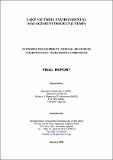Economic development: natural resources interventions / investments component
Author
Date
2007Type
Reportviews
downloads
Metadata
Show full item recordxmlui.dri2xhtml.METS-1.0.item-citation
Economic development: natural resources interventions / investments component
Abstract/
This study has underscored the imperative obligation especially on the part of the riparian states Kenya, Uganda and Tanzania to develop the abundant natural resources in the LVB and its extensive catchment to realize the potential income generation and employment benefits to reduce poverty in the basin and protect the ecosystem. For several decades, cumulative environmental degradation largely associated with human activities (industrial and urban effluence from the bordering towns and cities of Lake Victoria), run off rain water and diminishing oxygen in the lake have negatively affected the lake‘s ecosystem and reduced its natural resource base especially the fish stocks and certain plants resulting from diminishing size of wetlands and receding shores of the lake. To reverse Cumulative negative effect of decades of environmental degradation, the riparian states initiated in 1992 a multidisciplinary, multisectoral regional development programme. This has marked a major development initiative in the history of LVB. The commissioning of Lake Victoria Environmental management Project LVEMP I in 1997, the reestablishment of East African Community (EAC) in 1999 and subsequent Lake Victoria Basin Commission (LVBC) in 2003 have strongly internalized and consolidated the primary objectives of LVEMP I viz.: to transform LVB and its catchment into a socio-economic growth zone

